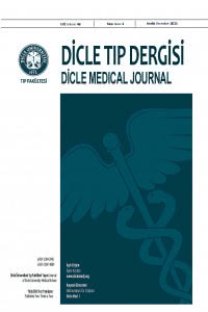Anti-TNF alfa kullanan hastalarda hepatit B reaktivasyonunun değerlendirilmesi
Evaluation of hepatitis B reactivation in patients receiving anti-TNF alpha
___
- 1. Aygen B, Demir AM, Gümüş M, et all. Immuno suppressive ther apyandthe risk of hepatitis B reactivation: Consensusreport. Turk J Gastroenterol. 2018; 29: 259-69.
- 2. Ye H, Zhang XW, Mu R, et all. Anti-TNF therapy in patientswith HBV infection--analysis of 87 patients with in flammatory arthritis. Clin Rheumatol. 2014; 33: 119-23.
- 3. Pérez-Alvarez R, Díaz-Lagares C, García-Hernández F, et all. Hepatitis B virus (HBV) reactivation in patients receiving tumornecrosis factor (TNF)-targeted therapy: analysis of 257 cases. Medicine (Baltimore). 2011; 90: 359-71.
- 4. Tavakolpour S, Alavian SM, Sali S. Hepatitis B Reactivation During Immuno suppressive Therapyor Cancer Chemotherapy, Management, and Prevention: A Comprehensive Review. HepatMon. 2016; 16: e35810.
- 5. Pattullo V. Prevention of Hepatitis B reactivation in thesetting of immunosuppressionClinMolHepatol. 2016; 22: 219–37.
- 6. Nard FD, Todoerti M, Grosso V, et all. Risk of hepatitis B virusreactivation in rheumatoidarthritispatientsu nder going biologictreatment: Extending perspective from oldtonewerdrugs. World J Hepatol. 2015; 7: 344-61.
- 7. Reddy KR, Beavers KL, Hammond SP, Lim JK, FalckYtter YT. American Gastroenterological Association Institute guideline on the prevention and treatment of hepatitis B virus reactivation during immuno suppressivedrug therapy. Gastroenterology. 2015; 148: 215-9.
- 8. Chiu YM, Lai MS, Chan KA. Commen surate in cidence and outcomes of liverenzyme elevation between antitumornecrosis factorusers with orwith outpriorhepatitis B virusinfections. PLoSOne. 2018; 13: e0196210.
- 9. Biondo MI, Germano V, Pietrosanti M, et all. Lack of hepatitis B virus reactivation after antitumournecrosis factor treatment in potentialoc cultcarriers with chronic in flammatory arthropathies. Eur J Intern Med. 2014; 25: 482-84.
- 10. Clarke WT, Amin SS, Papamichael K, Feuerstein JD, Cheifetz AS. Patients with core antibody positive and surfaceantigen negative Hepatitis B (anti-HBc+, HBsAg-) on anti-TNF therapyhave a low rate of reactivation. ClinImmunol. 2018; 191: 59-62.
- 11. Cannizzaro MV, Franceschini C, Esposito M, Bianchi L, Giunta A. Hepatitis Breactivation in psoriasispatientstreated with anti-TNF agents: prevention and management. Psoriasis (Auckl). 2017; 7: 35-40.
- ISSN: 1300-2945
- Yayın Aralığı: 4
- Başlangıç: 1963
- Yayıncı: Cahfer GÜLOĞLU
Yaşlı Hastalarda Aşırı Aktif Mesane Tedavisinde Mirabegron Tedavisinin Oküler ve Sistemik Güvenliği
Murat AKGÜL, Cenk YAZICI, Ersan ARDA, Haluk AKPINAR
Hatice ÖNTÜRK, Koray OKUR, Eylem KUDAY KAYKISIZ
Hatice DÜLEK, Zeynep TUZCULAR VURAL, Işık GÖNENÇ
Salih YILDIRIM, YAVUZ ORAK, Rukiye MENENCİOĞLU, Ahmet ALTUN, Filiz ORAK, Cevdet DÜGER, Esra ÖZPAY, Fatih YAZAR
Neonatal hearing test results in the Çukurova region
Sanem ERKAN, Birgül TUHANİOĞLU
CENK MURAT YAZICI, HACI MURAT AKGÜL, ERSAN ARDA, Haluk AKPINAR
Eylem Kuday KAYKISIZ, HATİCE ÖNTÜRK, Koray OKUR
Mehmet ŞEKER, Oktay OLMUŞÇELİK, Naciye Çiğdem ARSLAN, Pelin BASIM, İrem ÖZÖVER, Yaşar ÖZDENKAYA, Cenk ERSAVAŞ
Konjenital Miyojenik Pitoz Vakalarında Maksimum Levator Rezeksiyonu Prosedürünün Sonuçları
Yakup GÜNEŞ, Umut DAĞ, Selahattin BALSAK, Sevim ÇAKMAK, Uğur KEKLİKÇİ
